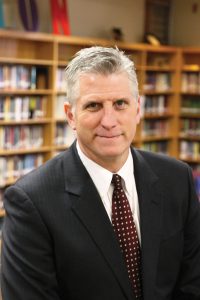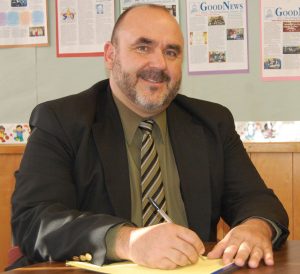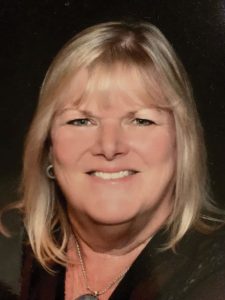When Gov. Phil Murphy and the New Jersey Department of Education announced April 1 that nearly $18 million in federal American Rescue Plan recovery funds would be allocated to reimburse local educational agencies for additional special education services, it drew attention to students who have been hit particularly hard by the pandemic.
As a result of legislation the governor signed in June 2021 (S-3434), LEAs must offer up to one year of additional or compensatory special education for impacted students in the 2020-2021, 2021-2022, and 2022-2023 school years, if a student’s individualized education program team determined such services are needed.
The late James Gaffney, a longtime member of the Oakland Board of Education in Bergen County, former president of the Bergen County School Boards Association and a special education teacher with the Cliffside Park School District for 25 years, including eight years as a supervisor of instruction, spoke to School Leader shortly before his death April 23.
The pandemic has set special education students back – in most cases more than the general student population, he said.
Learning loss, mental anguish and uncertainty are battles that all students have to fight as a result of shutdowns or having been on a hybrid schedule. But for special education students and their teachers, those challenges tend to be more profound, he said.
“The things we are seeing now as opposed to academics, is we are seeing a lot of social emotional issues,” he said. “The big thing is we need to give them avenues of support, whether it is through a guidance counselor or teacher. All students have anxiety over what they have gone through the last couple of years.”

For Cliffside Park, a K-12 district in Bergen County, that is significant as students with an individualized education plan make up about 18% of the high school population, which encompasses about 1,500 students. Moreover, about 17% of students are English language learners, he said.
“It’s a good chance if you come into a classroom as a teacher, you’ll have an English language learner or a special education student,” he said.
While students are resilient, it is jarring for any student to enter 10th grade without having been in school in person for two years, Gaffney said. “This is that student’s first experience in secondary school,” he said. “It is overwhelming.”
Michael Nitti, superintendent of the Ewing Township School District in Mercer County, a K-12 district, agreed the pandemic has been tough on all students. “There is definitely learning loss and trauma involved,” he said. His district has about 3,500 students, which includes 653 in-district special education students. Seventy-two of them receive out-of-district education, and 53 receive speech therapy only.
The challenges would have been more profound, however, if Ewing had not given special education students the option to come back for in-person instruction beginning in September 2020, said Harry Louth, Ewing’s director of special services. He noted that more than 80% of the district’s special education students opted for in-person learning as soon as it became available as compared with about 55% of the overall student population.
“I think Mr. Nitti did a great job giving us the green light to bring our kids back when a lot of districts were hesitant,” Louth said. The district provided virtual instruction from March 2020 to June 2020 but was otherwise open for at least some in-person instruction.
“Teachers and child study team members vigorously recruited students for in-person instruction. We felt it was very important to encourage these children to come back to school, especially in the younger grades,” Louth said.

Ewing strived to reassure parents that it was safe to send their children back to school, Louth said. “But there was a time when we had abbreviated school days, which means the frequency and duration of instruction were impacted,” he said.
While the district navigated the pandemic as best as it could, you can see its lingering effects on special education students, Louth said. “There has been more anger and aggression between students,” he said.
Remote Learning Challenges When the pandemic first hit, there was no blueprint for how schools would teach special education students on a virtual basis. There were fundamental questions that needed to be answered, according to Cherie Adams, a founding member of Adams Gutierrez & Lattiboudere, LLC, a law firm that represents school districts around the state on education and employment-related matters, including special education. Adams also serves as president of the Belmar Board of Education in Monmouth County and is a member of the New Jersey School Boards Association’s Special Education Committee.

“The state and federal guidance was to provide as much as possible under the individualized education programs even though we were virtual,” Adams said. “But when the pandemic first started in March 2020, there was no authority for school districts to provide virtual related services, such as speech or counseling.”
While rules were modified to allow for the provision of virtual-related services, there was confusion about how to do it. For instance, providing physical therapy or occupational therapy services on a virtual basis was daunting if not impossible in some cases, she said.
There were also concerns about privacy, Adams said.
“I had clients prepare a notice to parents to indicate that if their child participated in a virtual group setting, the child could be seen or they might see other students and there might be other students whose information was available to them – and that they must maintain confidentiality,” she said. “We needed parents to understand the risks. We also wanted parents to recognize that counseling is supposed to be one on one and private – and they needed to give their child a private place to interact with the counselor.”
As it became obvious that the pandemic was going to last more than a couple weeks, there were larger questions, such as whether IEP plans could be modified, Adams said. There were other questions, too, such as how to evaluate or re-evaluate students in a virtual setting, Adams said.
Not the Same If they didn’t know it going in, teachers have quickly discovered that virtual learning does not compare with in-person instruction, Gaffney said.
“I would say a good 75% to 80% of the special education students I come in contact with … remote learning was damaging to them,” he said.
For special education students, in-person instruction is about more than learning how to pass a test. Physically going to school teaches them how to socialize with each other, how to follow rules and how to master soft skills to engage with the community, according to Gaffney.
“For two years, that was not being done,” Gaffney said. “Part of the challenge is that for special education students, things don’t sink in as quickly as someone without that disability. Meaning that they need repetition. But they went for two years without having that instruction and guidance.”
He continued, “I always say, academic wise, you get to where you have to go, but the social emotional wellness and the mental health of our students has been broken in some shape or form. Until we fix that, the 1 plus 1 equals 2 doesn’t really matter.”
Even after schools reopened, special education students were in a tough spot as they had to abide by social distancing rules that may not have been best for them, Adams observed. “Any child with a behavior issue or who is significantly disabled like being autistic on the spectrum may have difficulty with socializing in the first place, so staying apart may not be an issue … but getting them to reconnect may be a problem,” she said.
Another challenge was identifying students who may need special services.
“The earlier the intervention, the better off we are,” Gaffney said.
With hardly anyone going into homes to provide services, that type of intervention did not always happen during the peak of the pandemic, Adams said.
“Clearly, the other source of referral is when you have a child in a school and you see them struggling and having difficulty and you refer them to a child study team,” she said. “That was not a focus during the virtual instruction. Moreover, you might not see a student’s propensity to be distracted and other things when providing virtual instruction that would lead to a referral.”
In Ewing, some teachers kept instruction low tech even when school was closed to in-person learning or when a student opted to stay home, Louth said.
“The remote learning required navigation and skills that were not present prior to the pandemic, so it was difficult for some students to go to certain areas and retrieve information or a lesson that staff members had put online for them,” he said. “There was some frustration operating on a virtual platform.”
He continued, “There were definitely some age groups and classes where we kept it low tech and parents picked up packet work. They were not getting a lot out of the virtual assignments.”
Under Pressure Teaching on a virtual or hybrid basis has been challenging for teachers as well, Gaffney said. “We have to also be aware of the well-being of teachers and their mental health,” he said.
It was hard for special education teachers to do their job on a virtual basis, he said. “Teachers during the pandemic had to engage and motivate these young students …. If the class was 40 minutes, they may have only been able to get five minutes out of the student that day. But if you are in school and after 10 minutes a child is not able to focus on something, you could give them other activities to refocus them. You could teach them different strategies to get them back on track. But these poor teachers if after 10 minutes a child decided to check out, what do you do with that student?”
Some teachers resorted to giving what Gaffney calls “busy work,” such as watching a video and then taking 10 minutes to write a reaction to it. “But you can’t do that with special education students,” he said. “For many of them, if they could work 10 minutes by themselves, they would not be special education students. The toughest thing was to keep them engaged for 40 minutes. And when they came back to school in September, we had to teach them how to properly interact with other students in the classroom.”
Gaffney saw the consequences of remote learning on a daily basis.
“For middle school students, I see the social immaturity,” he said. “They don’t know how to react properly in situations. They don’t know how to take someone telling them what to do. That part of it is tough.” He added, “We have good days and bad days, and I am hoping by September we are back to whatever the new normal is … but it’s not going to be what it was.”
Despite these challenges, Gaffney has been impressed with how resilient students have been, including adapting to wearing masks.
But while many special education students may have fared well with wearing a mask, others were prevented from wearing them for medical reasons, which could cause a host of issues for schools, Adams said.
“My view in talking with districts was that if a student could not tolerate a mask for medical reasons, that is one thing, but if they couldn’t because of behavior, that was something they needed to be working on – to tolerate a mask for longer,” she said.
With that said, some special education students – even if they could tolerate a mask – had to see the mouth movements of a speech therapist – and masks were not always feasible.
The result was parents were sometimes concerned about special education students who were not wearing masks, whether it be for medical or instructional reasons, as some of them felt that was exposing their own children to COVID-19, Adams said.
The pandemic also caused other challenges, including parents lobbying for schools to place a special education student out of district at a private school that remained open during the pandemic, Adams said. “I would tell schools just because a school was open was not a reason to support out-of-district placement because everyone was dealing with the pandemic,” she said.
For Ewing, out-of-district special education students were a challenge mainly because parents were not happy that other schools did not reopen as soon as they did, Louth said. “Parents were quick to let us know they didn’t like it,” Louth said, referring to the inability for those students to receive in-person instruction. “It was a difficult situation for us because they are out of district for a reason.”
With schools reopened, the issues have shifted, but the theme of parents trying to send their children elsewhere has remained an issue for some districts, Adams said.
“I’ve seen litigation from parents wanting out-of-district placements because they are saying they have to pull a child because they are not progressing,” Adams said. “To some degree, they are ignoring the impact of everyone being out of school and not just their child.”
Those unilateral placement cases had been coming up more frequently, even before the pandemic, Adams said. “There are lots of cases where the demands for unilateral placement are excessive and not because a district can’t provide an appropriate program,” she said.
Sometimes, school districts give in to parental demands as they are afraid of costly litigation that may end with them being required to pay the attorney fees of plaintiffs. “A lot of times, school boards don’t want to take that risk, and that may increase the number of disputes,” Adams said.
Despite an infusion of COVID-19 relief funds, another challenge for districts is the sheer cost of providing special education services.
“The Individuals with Disabilities Education Act is the greatest thing in the world for students with disabilities to make sure special education students have funding,” Gaffney said. “But the problem is that a lot of the mandates are unfunded, but you have to do them anyway.”
Many school districts will think they are in a pretty good position in terms of the budget, but all it takes is for one or two families to move into the district with a student that has a significant disability to set you back, Gaffney said. “You have to provide for them, so it could be a $200,000 per year tuition bill with transportation,” he said. “If that is what that young person was getting, they are going to get it again, so all of a sudden you take a $200,000 hit. We are here for the kids, and we have to figure it out.”
Adams shares that concern, noting that in Belmar, a special education student moved into the district and needed to be transported to Princeton. “That placement cost well over $100,000 per year,” she said. “It was monumental for a district with a budget like ours.”
Nitti said, “Sustainable funding is needed because issues from the pandemic are not going to be addressed in a year or two. There are social emotional concerns, learning loss … it’s one thing to throw a bunch of money at districts, but it has to be sustained so students can bounce back from this turbulent time.”
Scarcity of Teachers While there is a teacher shortage overall, special education teachers are even harder to come by, according to Gaffney.
For certain subjects like science, it’s very difficult to find a teacher who is willing – and qualified – to teach special education students, Gaffney said. “As a science teacher, you don’t have to get a special education certification to better your career,” he said, adding that it is tough to keep regular science teachers as they often leave teaching to take higher-paying jobs in the private sector.
The market for teachers in general has become so competitive that Gaffney has heard of teachers leaving their districts in the middle of the school year and taking a job in a different district. “I’ve never seen that before,” he said. “But some are choosing to work somewhere else because they are going to earn $10,000 more.”
Getting that special education credential, however, can make a lot of sense for a teacher who wants to get tenure, Gaffney said. “Some years ago, we had three biology teachers at our district, and we told them that whichever one gets their special education certification first is guaranteed a job here as long as they want it,” he said. “One young man went out and got it and never looked back and the other two are not here anymore because we had too many biology teachers. So, now he is a science special education teacher.”
Even school districts with enough special education teachers are running into problems getting them to teach summer school, Gaffney said.
“Before the pandemic, we would have teachers lining up to work for four to six weeks,” he said. “But teachers – especially this year – they are burnt out. They just want to take that summer and get themselves in a good place again. The young teachers and nontenured teachers have a little more free time on their hands and are more apt to teach summer school, but I’m finding that the older teachers are just tired and want a break.”
Ewing issued a call for summer-school teachers earlier than usual this year, sweetening the prospect with higher pay, Louth said. “If we can sustain the funding, I think we can really address learning loss,” he said.
But the biggest challenge in the aftermath of the pandemic, Gaffney said, is “to get our students to feel good about themselves.”
